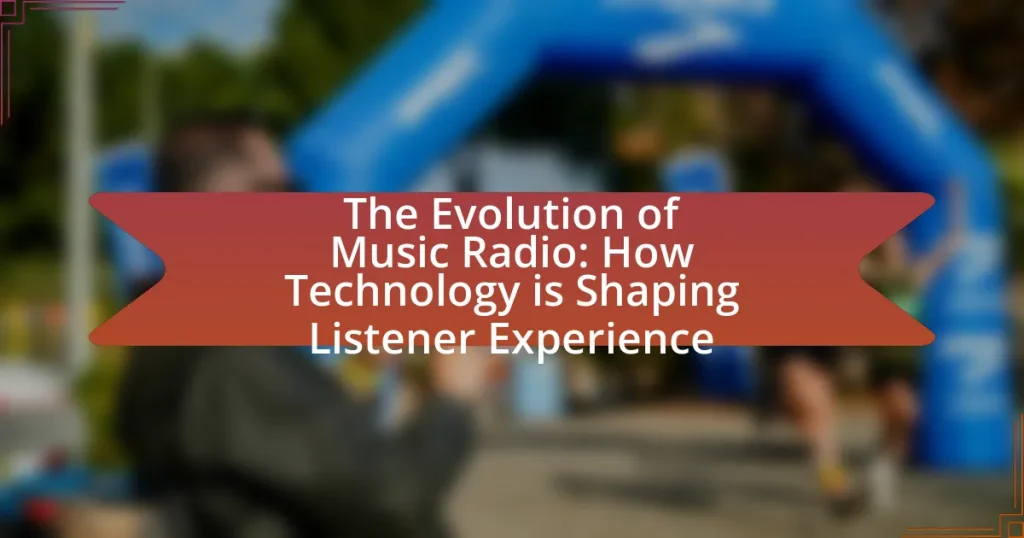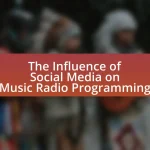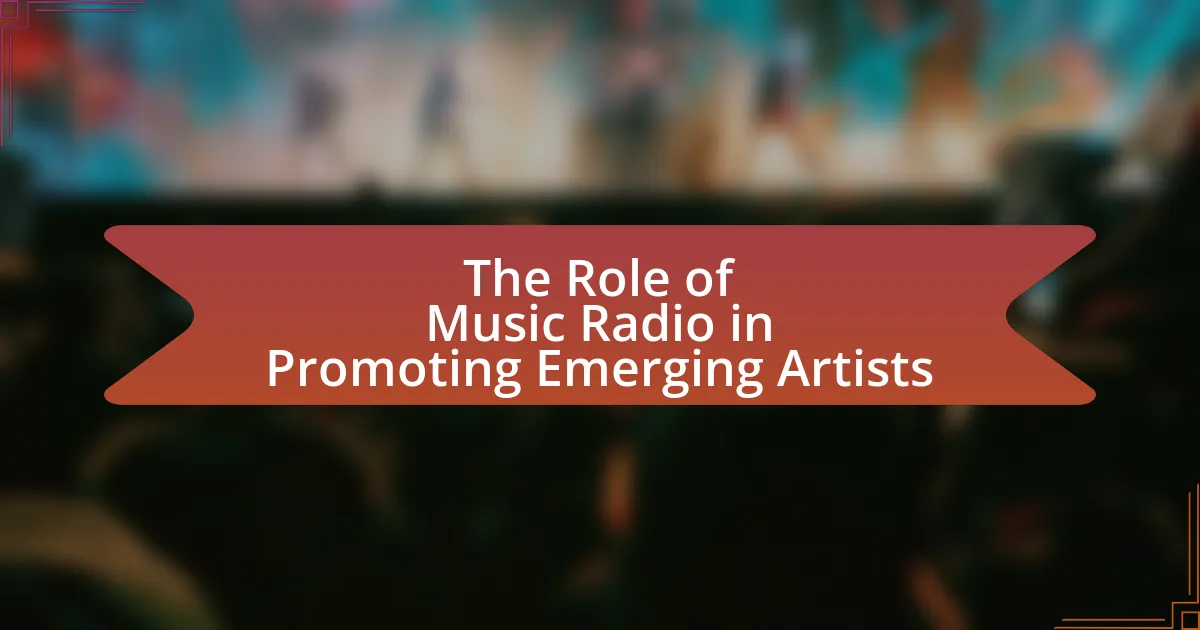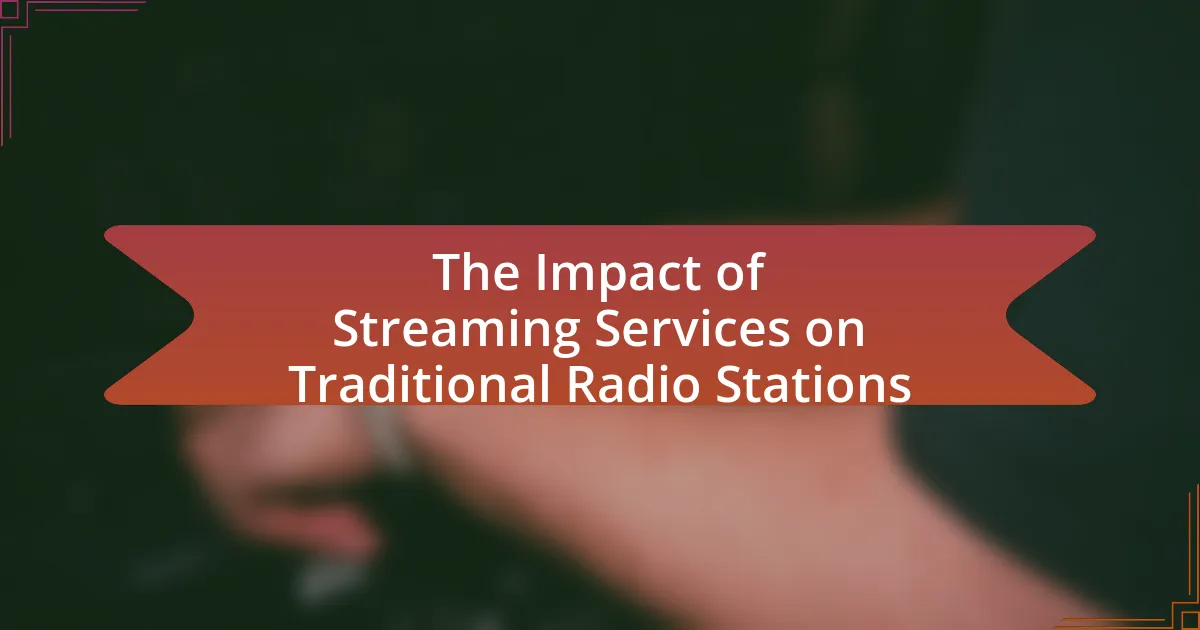The article examines the evolution of music radio, highlighting how technological advancements have transformed listener experiences over the decades. It traces the history from the introduction of AM and FM broadcasting to the rise of digital streaming platforms, illustrating key milestones such as the emergence of rock and roll stations and the impact of the internet on music accessibility. The discussion includes the role of algorithms in personalizing content, the influence of social media on listener engagement, and the challenges traditional radio faces in adapting to new technologies. Additionally, it explores future trends, including the potential of artificial intelligence and virtual reality in reshaping music radio.
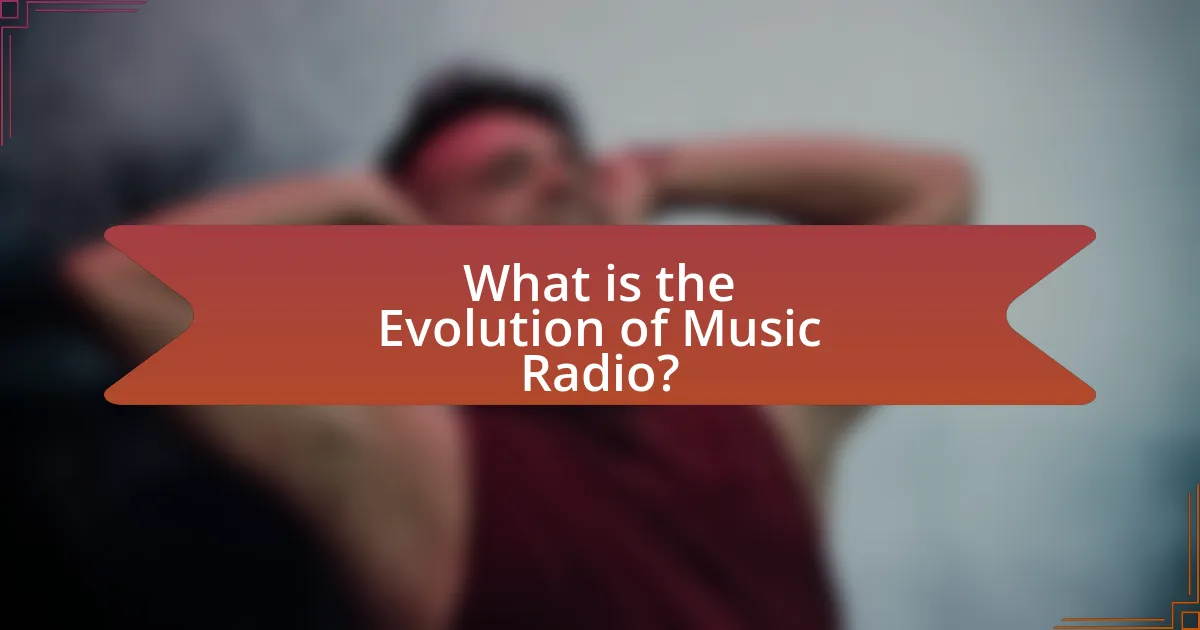
What is the Evolution of Music Radio?
The evolution of music radio began with the advent of AM broadcasting in the early 20th century, which allowed for the transmission of audio content over long distances. This was followed by the introduction of FM radio in the 1930s, which provided higher sound quality and became popular for music broadcasting. The 1960s and 1970s saw the rise of rock and pop music stations, significantly shaping youth culture and music trends. The advent of digital technology in the late 20th century led to the emergence of satellite radio and internet streaming, expanding access to diverse music genres and personalized listening experiences. By 2020, over 60% of Americans reported listening to online radio, highlighting the shift from traditional broadcasting to digital platforms. This progression illustrates how technological advancements have continually transformed music radio, enhancing listener engagement and accessibility.
How has music radio changed over the decades?
Music radio has transformed significantly over the decades, primarily due to advancements in technology and changes in listener behavior. In the 1920s, music radio began as a novelty, with AM broadcasting introducing a wide audience to music. By the 1950s, FM radio emerged, offering higher sound quality and a broader range of music genres, which led to the rise of rock and roll. The 1980s saw the introduction of digital broadcasting and the proliferation of radio formats, catering to niche audiences.
In the 2000s, the advent of the internet revolutionized music radio, with streaming services like Pandora and Spotify providing on-demand access to vast music libraries, diminishing the role of traditional radio. Today, music radio incorporates digital platforms, podcasts, and personalized playlists, allowing listeners to curate their experiences. According to a 2021 report by the Nielsen Company, 88% of Americans still listen to radio weekly, but the medium has adapted to include digital streaming and mobile apps, reflecting the ongoing evolution of listener preferences.
What were the key milestones in the history of music radio?
The key milestones in the history of music radio include the first commercial radio broadcast in 1920, which marked the beginning of music radio as a medium. In 1930, the introduction of FM radio improved sound quality significantly, enhancing the listening experience. The launch of rock and roll radio stations in the 1950s transformed music radio by targeting youth culture and popularizing new genres. The advent of satellite radio in the late 1990s expanded the reach and variety of music programming, while the rise of internet radio in the early 2000s democratized access to music, allowing for niche genres and independent artists to gain exposure. Each of these milestones reflects technological advancements that shaped listener experiences and the music industry.
How did the introduction of FM radio impact music broadcasting?
The introduction of FM radio significantly enhanced music broadcasting by providing superior sound quality and reduced interference compared to AM radio. FM radio’s frequency modulation technology allowed for a clearer and more dynamic audio experience, which was particularly beneficial for music transmission. This shift led to a greater emphasis on music programming, as stations could now offer a more enjoyable listening experience, resulting in increased audience engagement. By the late 1960s, FM radio accounted for a substantial portion of music broadcasting, with the number of FM stations growing rapidly, reflecting its popularity and the industry’s adaptation to listener preferences for high-fidelity sound.
What role has technology played in the evolution of music radio?
Technology has been pivotal in the evolution of music radio by transforming how content is produced, distributed, and consumed. The introduction of FM broadcasting in the 1960s significantly improved sound quality, while the advent of digital broadcasting in the 1990s allowed for clearer signals and more channels. The rise of the internet in the late 1990s and early 2000s enabled streaming services, which expanded access to music radio beyond traditional geographic limitations. Additionally, mobile applications and smart speakers have further enhanced listener engagement by allowing users to access music radio anytime and anywhere. These technological advancements have collectively reshaped the listener experience, making music radio more accessible and interactive.
How did the advent of the internet change music radio?
The advent of the internet transformed music radio by enabling streaming services and on-demand access to music, significantly altering how listeners consume audio content. Traditional radio was limited to scheduled programming and geographic constraints, while the internet allowed for global access to diverse music genres and personalized playlists. According to a 2021 report by the Pew Research Center, over 50% of Americans now listen to music through online streaming platforms, showcasing a shift from conventional radio to internet-based services. This transition has led to the rise of platforms like Spotify and Apple Music, which offer tailored listening experiences and have reshaped the music industry landscape.
What are the implications of digital streaming on traditional radio?
Digital streaming significantly impacts traditional radio by diverting audiences and altering advertising revenue models. As listeners increasingly prefer on-demand content, traditional radio faces declining listener numbers; for instance, a 2021 Nielsen report indicated that weekly radio listenership dropped to 82% from 90% in 2015. Additionally, digital streaming platforms often provide targeted advertising, which traditional radio struggles to match, leading to a shift in advertising budgets away from conventional radio. This transition challenges traditional radio’s relevance and financial sustainability in an evolving media landscape.
Why is understanding the evolution of music radio important?
Understanding the evolution of music radio is important because it reveals how technological advancements have transformed listener experiences and shaped cultural consumption of music. The transition from AM to FM, the introduction of digital broadcasting, and the rise of streaming services illustrate significant shifts in accessibility and content delivery. For instance, the Federal Communications Commission’s 1960 decision to allocate more FM frequencies led to a diversification of music genres on the airwaves, enhancing listener choice. Additionally, the advent of internet radio in the late 1990s expanded global access to music, allowing niche genres to thrive and fostering a more inclusive music community. These developments underscore the critical role of technology in influencing how audiences engage with music, making it essential to understand this evolution for insights into current and future trends in the industry.
How does the evolution of music radio reflect broader cultural shifts?
The evolution of music radio reflects broader cultural shifts by illustrating changes in technology, audience preferences, and societal values. For instance, the transition from AM to FM radio in the 1960s marked a shift towards higher sound quality and a focus on music over talk, aligning with the counterculture movement that prioritized artistic expression. Additionally, the rise of digital streaming platforms has transformed radio into a more personalized experience, reflecting a cultural shift towards individualism and on-demand content consumption. This shift is evidenced by the decline of traditional radio listenership, which fell from 93% in 2000 to 83% in 2020, as audiences increasingly favor platforms like Spotify and Apple Music that cater to personal tastes. Thus, the evolution of music radio serves as a mirror to the changing dynamics of culture, technology, and listener engagement.
What can we learn from the history of music radio for future developments?
The history of music radio teaches us that adaptability and technological integration are crucial for future developments. For instance, the transition from AM to FM radio in the 1960s demonstrated how improved sound quality and programming diversity could enhance listener engagement. Additionally, the rise of digital streaming platforms has shown that incorporating user preferences and data analytics can significantly personalize the listening experience. Historical shifts, such as the introduction of satellite radio in the 1990s, further illustrate the importance of expanding access and content variety to meet evolving consumer demands. These lessons highlight the need for future music radio developments to focus on innovation, audience interaction, and leveraging technology to remain relevant in a competitive landscape.

How is Technology Shaping the Listener Experience?
Technology is shaping the listener experience by providing personalized content, enhancing accessibility, and enabling interactive engagement. Streaming services like Spotify and Apple Music utilize algorithms to analyze user preferences, delivering tailored playlists and recommendations that cater to individual tastes. Additionally, advancements in mobile technology and internet connectivity allow listeners to access music and radio content anytime and anywhere, significantly broadening the audience reach. Interactive features, such as live chats and social media integration, foster a two-way communication channel between listeners and creators, enriching the overall experience. These technological innovations have transformed how audiences consume music, making it more engaging and user-centric.
What technological advancements are currently influencing music radio?
Technological advancements currently influencing music radio include streaming services, artificial intelligence, and mobile applications. Streaming services like Spotify and Apple Music have transformed how listeners access music, allowing for personalized playlists and on-demand content. Artificial intelligence is being utilized for music recommendation algorithms, enhancing user experience by predicting listener preferences based on their behavior. Additionally, mobile applications enable users to listen to radio stations from anywhere, increasing accessibility and engagement. According to a report by the Pew Research Center, 41% of Americans now listen to online radio, highlighting the significant impact of these technologies on the music radio landscape.
How do mobile apps enhance the music radio experience?
Mobile apps enhance the music radio experience by providing users with personalized content, on-demand access, and interactive features. These applications allow listeners to create custom playlists, discover new artists through algorithms, and receive recommendations based on their listening habits. For instance, platforms like Spotify and Pandora utilize data analytics to tailor music selections, significantly improving user engagement. Additionally, mobile apps often include features such as live streaming, social sharing, and the ability to interact with DJs or hosts, which fosters a more immersive and participatory listening experience. According to a report by eMarketer, over 70% of U.S. adults use mobile apps for music streaming, highlighting their integral role in modern music consumption.
What role do algorithms play in personalizing listener experiences?
Algorithms play a crucial role in personalizing listener experiences by analyzing user data to tailor content recommendations. These algorithms utilize machine learning techniques to assess listening habits, preferences, and behaviors, enabling platforms to suggest songs, artists, or playlists that align with individual tastes. For instance, Spotify’s recommendation system employs collaborative filtering and natural language processing to curate personalized playlists, resulting in a 30% increase in user engagement according to internal metrics. This data-driven approach enhances user satisfaction and retention by ensuring that listeners receive content that resonates with their unique preferences.
How are listeners interacting with music radio differently today?
Listeners are interacting with music radio differently today primarily through digital platforms and personalized content. The rise of streaming services and mobile applications has shifted listener engagement from traditional FM/AM radio to online platforms, allowing users to curate their playlists and access a wider variety of music. According to a 2022 report by Nielsen, 63% of U.S. adults now listen to music through streaming services, compared to just 18% who primarily use traditional radio. This shift has led to increased interactivity, as listeners can now engage with radio stations via social media, request songs in real-time, and participate in live chats during broadcasts, enhancing their overall experience.
What are the effects of social media on listener engagement with music radio?
Social media significantly enhances listener engagement with music radio by facilitating real-time interaction and community building. Platforms like Twitter and Instagram allow listeners to share their thoughts on songs, participate in polls, and engage with radio hosts, creating a more interactive experience. According to a study by the Pew Research Center, 72% of adults use social media, which indicates a vast audience that radio stations can tap into for feedback and promotion. This interaction not only increases listener loyalty but also provides valuable data for radio stations to tailor their content to audience preferences.
How has the rise of podcasts changed the landscape of music radio?
The rise of podcasts has significantly transformed the landscape of music radio by providing listeners with on-demand, niche content that traditional radio cannot match. This shift has led to a decline in traditional radio listenership, as audiences increasingly prefer the flexibility and variety offered by podcasts. According to a 2021 report by Edison Research, 41% of Americans aged 12 and older listen to podcasts monthly, indicating a growing preference for this medium over conventional radio. Additionally, the ability for creators to produce specialized content has allowed for a broader range of musical genres and discussions, catering to diverse listener interests that traditional radio often overlooks.

What are the Future Trends in Music Radio?
Future trends in music radio include increased personalization through AI algorithms, the integration of interactive features, and the rise of podcasting as a complementary medium. AI-driven platforms analyze listener preferences to curate tailored playlists, enhancing user engagement. Interactive features, such as live requests and social media integration, allow listeners to participate actively in programming. Additionally, the growth of podcasting offers on-demand content, attracting audiences seeking niche topics and storytelling formats, thereby expanding the traditional radio landscape. These trends reflect the ongoing evolution of music radio in response to technological advancements and changing listener behaviors.
How might emerging technologies further transform music radio?
Emerging technologies will further transform music radio by enhancing personalization and interactivity for listeners. Innovations such as artificial intelligence and machine learning enable radio platforms to analyze listener preferences and curate customized playlists, significantly improving user engagement. For instance, AI-driven algorithms can predict songs that align with individual tastes, as evidenced by platforms like Spotify, which reported that personalized playlists increase user retention by over 30%. Additionally, advancements in streaming technology and mobile applications allow for seamless access to global music content, enabling listeners to discover diverse genres and artists. This shift towards a more tailored and accessible listening experience is reshaping the traditional radio landscape, making it more relevant in the digital age.
What potential does artificial intelligence hold for music radio?
Artificial intelligence holds significant potential for music radio by enhancing personalization, improving content curation, and optimizing operational efficiency. AI algorithms can analyze listener preferences and behaviors, allowing radio stations to tailor playlists and recommendations to individual tastes, thereby increasing listener engagement. For instance, platforms like Spotify utilize AI-driven analytics to create personalized playlists, which has been shown to boost user satisfaction and retention rates. Additionally, AI can automate tasks such as scheduling and content generation, streamlining operations and reducing costs for radio stations. This integration of AI not only transforms the listener experience but also positions music radio to adapt to evolving consumer demands in a competitive landscape.
How could virtual reality change the way we experience music radio?
Virtual reality could transform the way we experience music radio by creating immersive environments that enhance listener engagement. In a virtual reality setting, users can interact with 3D representations of artists, attend virtual concerts, and explore music-themed environments, making the listening experience more dynamic and participatory. Research indicates that immersive audio experiences can significantly increase emotional connection to music, as demonstrated in studies showing that users report higher satisfaction and engagement levels when using VR for music experiences compared to traditional formats. This shift towards an interactive and immersive format could redefine how audiences connect with music radio, moving beyond passive listening to active participation.
What challenges does music radio face in adapting to new technologies?
Music radio faces significant challenges in adapting to new technologies, primarily due to competition from streaming services and changing listener habits. The rise of platforms like Spotify and Apple Music has shifted audience preferences towards on-demand content, leading to a decline in traditional radio listenership. According to a Nielsen report, in 2020, 63% of Americans aged 18-34 preferred streaming services over traditional radio, highlighting this shift. Additionally, music radio must invest in digital infrastructure and talent to create engaging online content, which can strain budgets and resources. The need for real-time data analytics to understand listener preferences further complicates adaptation efforts, as many traditional stations lack the necessary technology and expertise.
How can traditional radio stations compete with digital platforms?
Traditional radio stations can compete with digital platforms by enhancing their content quality and leveraging local engagement. By focusing on unique programming, such as live local events, interviews with community figures, and tailored playlists that reflect local culture, radio stations can differentiate themselves from the vast array of digital options.
For instance, according to a 2021 Nielsen report, 92% of Americans still listen to radio weekly, indicating that local content remains relevant. Additionally, integrating digital tools like social media interaction and mobile apps can help traditional stations reach younger audiences who prefer digital engagement. This combination of quality content and digital integration allows traditional radio to maintain its audience while attracting new listeners.
What strategies can be employed to retain listeners in a digital age?
To retain listeners in a digital age, music radio stations can employ strategies such as personalized content delivery, interactive engagement, and leveraging social media platforms. Personalized content delivery, which includes using algorithms to recommend music and shows based on listener preferences, has been shown to increase listener satisfaction and retention rates. For instance, platforms like Spotify utilize data analytics to tailor playlists, resulting in higher user engagement. Interactive engagement through live polls, listener requests, and contests fosters a sense of community and connection, encouraging listeners to stay tuned. Additionally, utilizing social media platforms for real-time interaction and promotion can enhance visibility and attract a broader audience, as evidenced by the success of radio stations that actively engage with listeners on platforms like Instagram and Twitter. These strategies collectively create a more engaging and personalized listening experience, crucial for retaining audiences in a competitive digital landscape.
What best practices can enhance the listener experience in music radio?
To enhance the listener experience in music radio, stations should prioritize audience engagement, personalized content, and high-quality audio. Engaging listeners through interactive features, such as live requests and social media integration, fosters a sense of community and connection. Personalized content, achieved through data analytics and listener preferences, ensures that programming aligns with audience tastes, increasing satisfaction and retention. High-quality audio, supported by advancements in streaming technology, provides a superior listening experience, which is crucial as studies show that sound quality significantly impacts listener enjoyment. These best practices collectively contribute to a more enjoyable and immersive music radio experience.
